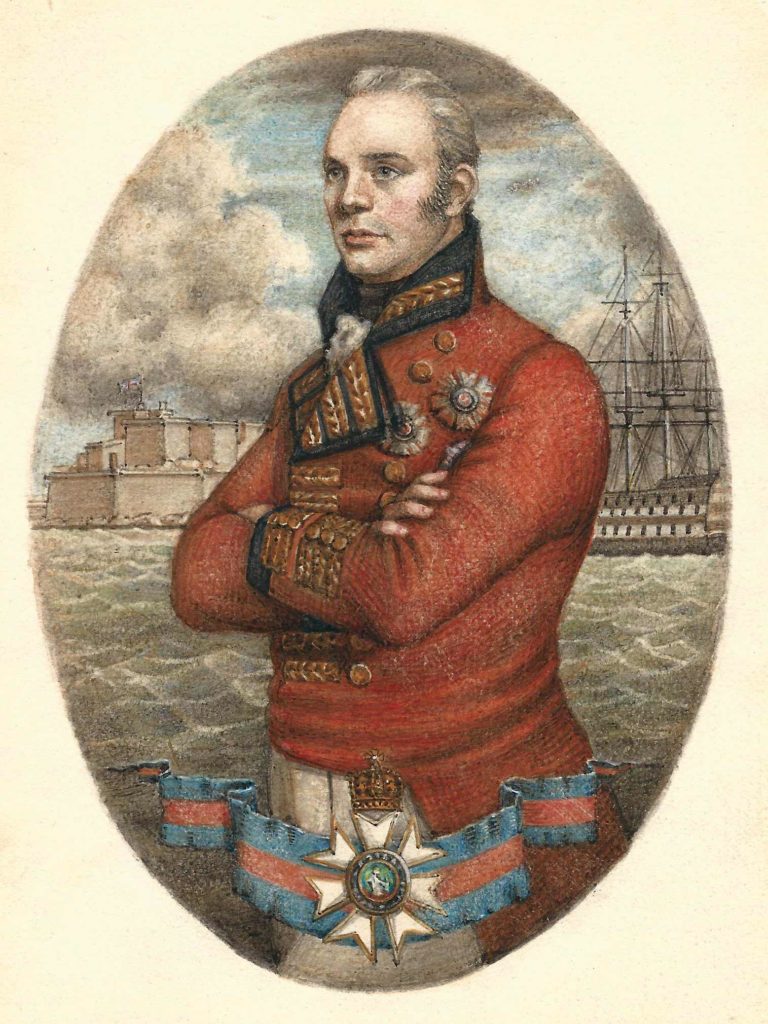

After commemorating the 205th anniversary of the battle of Waterloo we might legitimately consider the large number of British troops remaining on active duty on the Continent and the logistics required for their care and supply as well as their eventual re-embarkation for home. One of the general officers tasked with a variety of these logistics was Major-General Sir Manley Power. A fine miniature portrait of Power by Charles Jagger, recently auctioned in London, offers a perfect opportunity to review his career.
Power played no part in the Battle of Waterloo, however, the part he played in the Peninsular War earned him the respect of the Duke of Wellington so that when Power became available in 1815 after service in North America he joined the Duke on the Continent.
Power was born in 1775 and had an early initiation into the army: his first commission at the tender age of nine or ten was gained as ensign in the 20th Foot in August 1783; he was promoted lieutenant in 1789; captain in 1793; major in 1799 and lieutenant-colonel in 1801.
After serving two years in Halifax, Nova Scotia (1795-97), he participated in the unsuccessful expedition to the Netherlands in 1799 and subsequently served in Minorca in 1800. The following year his regiment joined Sir Ralph Abercromby’s expedition to Egypt where he was present at the siege and surrender of the French at Alexandria on 31st August 1801.
With the signing of the Treaty of Amiens in 1802 Power went on half-pay however from 1803 to 1805 he acted as assistant adjutant-general at Horse Guards, London. On 6th June 1805 he was made lieutenant-colonel of the 32nd foot and became colonel in the army in 1810.
Manley Power’s initial appointment in the Peninsular War was with the Duke of Wellington’s army in Spain. His experience commanding Portuguese troops led to his reassignment to a Portuguese brigade under Lieutenant-General William Carr Beresford.
In 1812 Power was included in the House of Commons’ vote of thanks accorded to the

together with Lieutenant-General Beresford and the general officers of the Portuguese service under his command “for their distinguished exertions during the recent siege of Badajoz, which was so gloriously terminated by the successful assault of that important fortress.” [1]
One of the Portuguese strategies during the Peninsular War was to place their troops under British command. These had been poorly trained, but under Manley Power’s leadership, the Portuguese troops were eventually regarded as equivalent to hardened British units and were referred to as “Power’s Portuguese”; they were heavily involved in many actions forming part of the 3rd Division led by Sir Edward Pakenham at the victories of Salamanca and Torres Vedras; and at Fuentes de Onoro and Vitoria under the command of Sir Thomas Picton.
For his services in Spain Power was awarded the Army Gold Cross with clasp, (Salamanca, Vitoria, Fuentes de Onoro, Torres Vedras, and Nivelle) appointed Knight Commander of the Portuguese Order of the Tower and Sword and made KCB in January 1815. His investiture as KCB was held on 8th June 1815 and he received permission to accept and wear the insignia of the Portuguese order on 25th June 1815.
[1] Parliamentary Debates, April 27, 1812.
It is these medals that are shown in Charles Jagger’s accomplished miniature portrait of Sir Manley Power executed in 1818. Most prominent, in the centre, is the Army Gold Cross and clasp hanging from its blue edged crimson neck ribbon; to the right is the neck badge of a Knight Commander of the Order of the Bath; to the left the equivalent of the Portuguese Order of the Tower and Sword. On his upper left breast is the Star of a Knight Commander of the Bath and below it that of Knight Commander of the Order of the Tower and Sword. It is not possible to tell whether the latter are bullion Stars or jeweler-made solid Stars however their placement suggests the latter.
An announcement in the British newspapers on 12th August 1818 reported that on the occasion of the coronation of the King of Portugal, His Majesty John VI ordered a list to be published of Officers who had distinguished themselves in the Peninsular Campaigns, enumerating the number of badges to be worn in commemoration of their successful services. The Duke of Wellington, as Marshal General, was attributed thirteen badges; Marshal Lord Beresford twelve and on downwards. Sir Manley Power was authorised to wear six badges. [2]
[2] The Sun, August 12, 1818, p. 1.

After the Peninsular War Manley Power served in North America in what became known as the War of 1812 which lasted until 1815. Power and at least two other Peninsula War veterans were deeply disappointed by Sir George Prevost’s caution at the Battle of Plattsburgh, New York, in 1814, in not pressing his attack to further advantage. Their critical opinions, which were highly respected in London, brought about Prevost’s removal as Commander-in-Chief, North America, and his substitution by Sir Edward Pakenham, Power’s previous commanding officer in the Peninsular War.
Power took part in the Battle of New Orleans, which was fought eighteen days after the signing of the Treaty of Ghent which formally ended the War in this theatre. The tragically futile loss of life was compounded by Pakenham’s own death in the heat of the battle.
On his return to Britain in 1815 Power was reassigned to the Continent to rejoin the 3rd Division, then under the command of Charles Colville, to lead the 2nd Brigade as part of the British army occupying Flanders and France.
Power’s duties during this time were quite diverse. One letter received from the Duke of Wellington dealt with reports of the damage caused to crops by British officers hunting and coursing through the countryside. The Duke admitted that he felt uncomfortable banning a sport in which he habitually participated and thus advised Power to instruct the officers involved to “avoid altogether riding over the cultivated ground, in the course of their Sport; and I would recommend that if any Officers should do so by accident the farmer should be spoken to and conciliated upon the subject; and that some measure should be adopted upon the spot to ascertain the damage he may have sustained, and to give him satisfaction for it.”
In October 1818 Power was advised that His Grace the Field Marshal had appointed him to superintend the embarkation of troops on their return home via Calais and that in “naming the Major-General to this service His Grace is confident that his intentions in this respect will be perfectly fulfilled.”
In the following year Power returned to the Mediterranean as Lieutenant Governor of Malta

to replace Lieutenant General John Thomas Layard. The newly appointed Lieutenant Governor was very much overshadowed by the imperious and irascible Governor, Sir Thomas Maitland, better known as “King Tom”. Maitland was also High Commissioner of the Ionian Islands and preferred to live in Corfu so it was Power who diligently carried out his master’s bidding during the latter’s long absences from Malta. Maitland was frequently away from Malta for anywhere between two and four months at a time however for the nineteen months between February 1820 and September 1821 Power administered the government of the Islands of Malta for all but ten days. It is therefore evident that Power acted as de facto Governor and yet despite his diligent service Sir Manley Power is barely remembered in Malta.
Maitland died unexpectedly in Malta on 17th January 1824 while visiting his friend the Rev. T. H. le Mesurier. If Power is remembered at all in Malta nowadays it is for his role in organizing Maitland’s magnificent state funeral which was held on 21st January. Maitland’s memorial is in the form of a plain sarcophagus located in the Upper Barrakka Gardens in Valletta, Malta. When, in December 2018, His Royal Highness the Duke of Kent visited Malta to inaugurate the exhibition celebrating the
bicentenary of the foundation of the Order of St Michael and St George he laid a wreath at Maitland’s memorial.
The year before his appointment to Malta Power married for a second time. His wife Anne, daughter of Kingsmill Evans, joined him in Malta soon after Power arrived in 1819. They had a daughter and two sons. Kingsmill Manley Power and Henry Manley Power were both born in Malta in 1819 and 1821 respectively. Anne Katherine who was born in Bath in 1823 died in Malta in June 1824 at the tender age of eighteen months.
Sir Manley Power was succeeded as Lieutenant Governor by Major-General Woodford in early 1826. As Power headed home to England via Switzerland he felt unwell and died unexpectedly in Berne after only twenty-three hours’ illness. He was just fifty-three years old. Lady Power survived her husband by 42 years, dying in 1869 at the age of 84.
To end on a more amusing, though equally melancholy, note the following epitaph dedicated to Power’s trusty charger who died in February 1815, was found amongst the Power family papers at Hereford County Record Office.
Here lies poor Grey a gallant steed
As ever graz’d the flowery mead,
No dangers could his heart appal
The gleaming steel or flying ball,
Upon Iberia’s bloodstained shore
In many a fight brave Power he bore,
O’er Pyrenees enwrapt in snow,
He boldly chas’d the routed foe,
And fierce amid the martial land
He proudly spurn’d the Gallic strand;
Escaping Death, tho’ worn with toil
Again he reach’d his native soil
When ah! His founder’d limbs no more
Could act the part they did before
But Tott’ring, scarcely could sustain
His body worn with age and pain –
In vain he ‘scap’d the flying ball
By one at last he met his fate,
His perils o’er, his labours cease,
Beneath this Elm, he sleeps in peace.
Acknowledgements
The author wishes to thank the staff at Hereford Record Office for the valuable assistance in sourcing information for this article.
Disclaimer: images are representative of awards.

